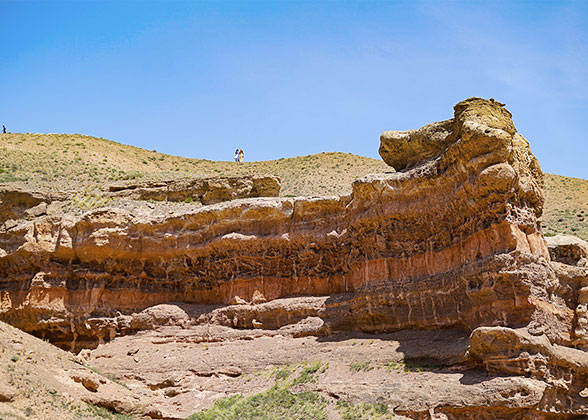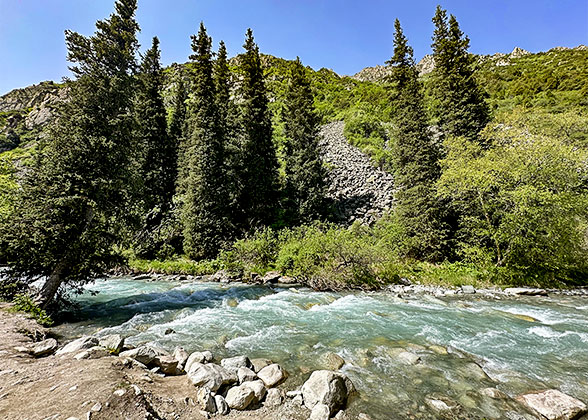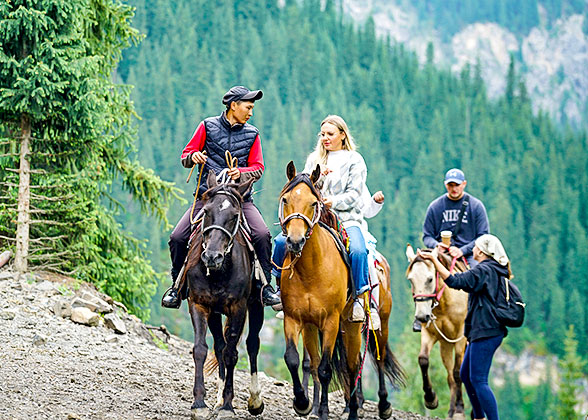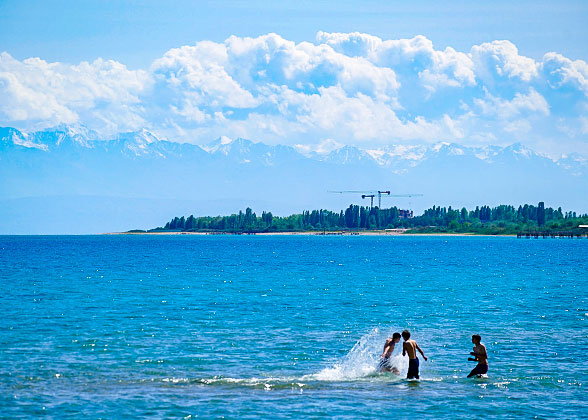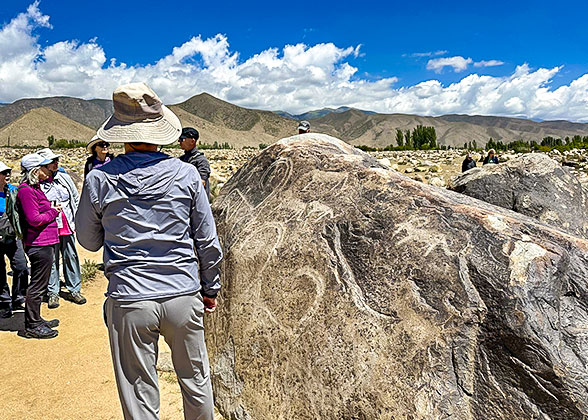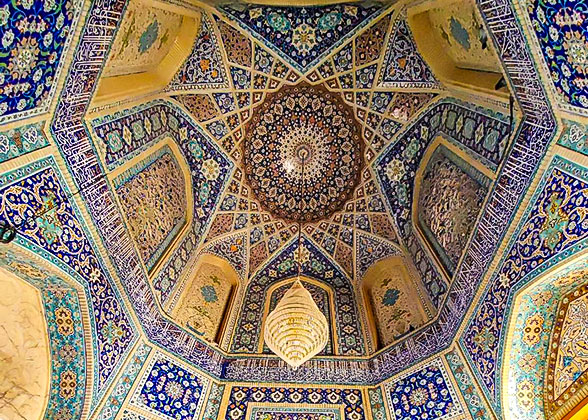Day 1: Airport Pick-up; Bishkek City Tour: Old Square, Oak Park, Ala-Too Square
The Open-Air Petroglyphs Museum Welcome to Kyrgyzstan! Upon your arrival in Bishkek, our driver and the guide will meet you and then escort you to the hotel for check-in. If time allows, kick off our discovery of the capital city, which will overturn your impression about Kyrgyzstan with its fascinating pre-Soviet Union history, going far beyond yurts and galloping nomads. Start with a stroll at Old Square, once a lively spot built to commemorate the October Revolution. Then followed by Oak Park, the oldest park in Bishkek, where you can enjoy the shade of oak trees that have been around as long as the city itself, dotted with over 90 outdoor sculptures and fountains. Our next stop will be Ala-Too Square, where the towering statue of Kyrgyz national hero Manas stands against the magnificent Heavenly Mountains. His legendary deeds were praised by local people for generations and had been compiled into an epic spanning over 500,000 lines, approximately twenty times longer than Homer’s Epics. There will be a changing of the guard ceremony at the hour, and if lucky, we’ll catch it and watch the guards’ marching and handover within 15 minutes. Conclude today’s sightseeing by admiring the exterior of the National Opera and Ballet Theatre of Abdylas Maldybayev, which is designed in ancient Greek style, topped with a statue of the Muse perched high above. After that, we’ll whisk you away to the hotel to rest and recharge for tomorrow’s exploration. ► Helpful Hints for Your Kyrgyzstan Tour 1. Currency: Credit cards are only accepted in some large hotels, cafes, and supermarkets, and ATMs might be scarce outside Bishkek. Given that most places don’t accept USD cash, you can exchange it into local som (USD 1 ≈ KGS 90) to cover all your expenses at downtown banks with Licensed Exchange logos. 2. Altitude Stress: We’ll hike in mountainous regions averaging over 2,000m (6,562 ft.) with a yurt camp accommodation above 3,500m (11,483 ft.), so to make the most of your experience, please avoid strenuous activities and alcohol one week before the trip. Also, prepare portable oxygen cylinders and painkillers as a precaution. Slowing down during the hike is another practical solution. If you have any discomfort, please inform your guide immediately. Accommodation: Ramada by Wyndham Bishkek Centre Hotel (4 stars) or similar
|
Day 2: Bishkek - Burana Tower - Chon Kemin Valley
After breakfast, we’ll leave Bishkek and drive 2 hours to Burana Tower, where echoes of the ancient Silk Road remain. This conical tower, built from red bricks and adorned with six geometric stripes, served as a minaret when the Kara-Khanid Khanate’s Khan (840-1212) converted from Zoroastrianism. It stands in the heart of Balasagun, a city founded by Sogdians in the 9th-11th centuries, which once had full water supply systems, multiple departments, and mosques, now preserving the Burana Tower only after the 13th-century Mongol invasion and several earthquakes. Over the years, the tower’s height was reduced from 48 meters (157 feet) to 25 meters (82 feet). We’ll ascend to the top for panoramic views of petroglyphs surrounding the tower, and please watch out for the steep and narrow spiral steps. Then embark on a 2-hour drive to the Chon Kemin Valley via the Chuy Valley, and soak up the postcard-worthy landscapes flashing by the window, where nomadic tribes have long battled over lush and fertile land for farming and grazing. Upon arrival in Chon Kemin Valley, we’ll check into a guest house on the edge of the Kemin Village. Afterward, you’ll embrace Kyrgyzstan’s classic scenery in the valley, from lush pastures and dense fir forests to clear lakes and magnificent mountains. Relax in a cozy spot or unleash your adventurous spirit to hike, fish, or ride horses at your own expense. Meals: Breakfast
Accommodation: Kok-Archa Guesthouse, Chon Kemin or similar
Burana Tower Konorchok Canyon
|
Day 3: Chon Kemin Valley - Boom Gorge - Konorchek Canyon - Kochkor Village
Wake up in a natural oasis to start your day! After breakfast, we’ll drive an hour to the Konorchok Canyon in the Boom Gorge, with the backdrop of towering rock formations and the Chuy River winding on either side. Lace up your hiking shoes and follow your guide to explore incredible red sandstone layers sculptured by wind and rain for 1 hour, reminiscent of the Grand Canyon. One remarkable site is the remains of an ancient volcano, dating back 2 million years, with scattered marine shell particles. After that, head to Kochkor Village and observe the shifting hues of water from blue and emerald green to black under the sun when you pass by the Orto-Tokoy Reservoir. In Kochkor, we’ll visit the Altyn Kol Workshop, an NGO run by local women artisans dedicated to preserving traditional felt carpet weaving of Shyrdak and Ala-Kiyiz, and providing income for unemployed women. From rolling wool and cutting shapes to sewing intricate designs, watch their nimble fingers flitting among the wool threads! These carpets are more than decorations to keep yurts cozy; they are often given as special gifts at weddings, which requires the joint efforts of all the women in the community. A medium-sized Shyrdak often takes 2 months. Our final stop is the local bazaar, mainly selling fresh produce and traditional clothing. Don’t miss trying Kymyz, the local fermented mare’s milk with a slightly salty and tangy flavor. Just a sip is enough, as more may cause diarrhea. Meals: Breakfast
Accommodation: Nomad Lodge Kochkor or similar
|
Day 4: Drive to Song Kol Lake via Kalmak Ashuu Pass, Visit a Nomad’s House
After breakfast, we’ll head to Song Kol Lake, a 2-hour drive with a crossing over the Kalmak Ashuu Pass (3,446 m). Along the way, enjoy views of picturesque villages and edelweiss-covered valleys. The unpaved road can be bumpy with cracks and gravel; taking motion sickness pills beforehand is recommended. ★ Experience Nomadic Life by Song Kol LakeNo place embodies Kyrgyzstan’s nomadic spirit more than Song Kol Lake! It is the country’s second-largest lake, gleaming amidst high mountain pastures like a utopia. From March to May, herdsmen migrate their livestock to this lush area and set up mushroom-shaped yurts across the grasslands. During this period, temperatures remain cool, and they depend on the stove in yurts for warmth. Due to limited high-altitude resources, their necessities are brought by truck; when coal is scarce, even cow dung becomes a valued fuel. You’ll be invited to a nomad’s home to learn about yurts’ elaborate structures and have the chance to milk horses or watch how to make Kymyz, a local sour-milk beverage. Between June and September, local children are on summer break, living nomadically with their families. Visiting during this time, you may feel a cozy ambiance when they open their hearts to talk and share a cup of milk tea with you. Bringing some candies may evoke their simple and innocent smiles. For a deeper experience, we’ve arranged yurt camp accommodations. After check-in, it’s your own time to truly unplug in this remote land. Watch cattle graze or ride a horse around the lake once acclimated to the altitude. Our camp also offers transparent boat riding for free, perfect for admiring aquatic life. Tonight, sleep in the camp decorated with delicate felt carpets, sometimes accompanied by the rustling sounds of cattle and horses. ► Important Tips: 1. The camp’s electricity is limited, so consider bringing a portable power bank for emergencies. 2. Song Kol Lake is cold year-round; even in August, average temperatures hover around 11℃ (52℉). Packing a windproof or light down jacket is essential. 3. Although the lake water appears crystal clear, please avoid drinking it without a filter, as horses, yaks, and sheep drink from it directly. Meals: Breakfast, Lunch, Dinner
Accommodation: Nomad’s Dream Yurt Camp, Song Kol Lake or similar
|
Day 5: Song Kol Lake - Issyk-Kul Lake - Bokonbayevo (Golden Eagle Hunting) - Skazka Canyon - Tamga
Today’s adventure will focus on the ‘Pearl of Kyrgyzstan’, Issyk-Kul Lake. It is the largest in the country and the second-largest alpine lake globally, glittering like a sapphire embraced by snow-capped peaks. We’ll drive along its southern shore for about 4.5 hours to Kyzyl-Tuu Village to observe the yurt-making process. Here, each family is dedicated to reviving nomadic culture, sharing their skills and stories with the next generation. They are responsible for crafting different yurt components such as wheels, frames, and felt carpets. The primary material is wood, which is collected in winter, dried, and steamed to create curves. Watch artisans assemble the wood into interlocking rhombus shapes secured with leather straps, and cover the framework with windproof and waterproof felt to complete a yurt. In the afternoon, let’s proceed to Bokonbayevo Village to witness the ancient golden eagle hunting tradition in Central Asia. The Kyrgyz affectionately refer to eagles as “birds of God”, regarding them as loyal companions and family members. Hunters often build strong bonds with their eagles from a young age through unremitting care, love, and training. During the golden eagle hunting demonstration, you’ll see a hunter on horseback with his eagle perched proudly on his arm. Following the hunter’s unique call, the bird will soar to find marked prey, often animal fur or a rabbit, then return and receive meat as a reward. Next, make our way to the yurt camp in Tamga for check-in and dinner. Afterwards, your guide will accompany you on a hike in the Skazka Canyon (Canyon Fairy Tale), where sandy yellow, red, and orange rock layers appear with curved wrinkles, looking so stark, only sparsely dotted with wildflowers and ferns. Please wear anti-slip shoes for the sandy trails. Finally, we’ll walk back to the yurt camp. Meals: Breakfast, Dinner
Accommodation: Nomad Lodge Tamga or similar
|
Day 6: Tamga - Juuku Valley - Jeti-Oguz Canyon - Karakol
On the sixth day, we’ll continue to explore the Issyk-Kul Lake’s southern shore to Karakol with a 1.5-hour drive, stopping at the Juuku Valley along the way. Stretch your legs in the sight of turbulent rivers framed by towering fir trees, with snow-capped mountains looming in the distance. The valley is rich in fauna, and you may encounter ibex or stone martens. For a more relaxing activity, consider unwinding your body in the valley’s well-known hot spring at your own expense. Our next stop is Jeti-Oguz Canyon, which means ‘seven bulls’, sharing its name with the most well-known rocks in the canyon. Hike along the opposite slope to better observe how a herd of bull-shaped rocks standing together has formed these impressive red sandstone cliffs and overlook the whole canyon. ‘Broken Heart’ is another popular rock formation, a heart-shaped opening in a narrow canyon, named after a local legend that a woman died of heartbreak after losing two suitors in a tragic duel. These spots are always crowded with eager photographers, so why not try to capture your own story? In the afternoon, we’ll arrive in Karakol, the country’s fourth-largest city. Its multicultural atmosphere combines Russian, Uyghur, and Dungan influences, which is evident in its architecture and cuisine. After settling into a local hotel, you can explore the city by yourself. ► Activities & Dinner Suggestion (at your own expense): Curious about Karakol’s past look? Take a stroll to the Russian Quarter, where colorful houses with exquisite wood carvings, built over 150 years ago by wealthy merchants, resemble gingerbread creations. An 8-minute walk northeast is Bugu Bazzar (Central Market), and you can browse stalls offering honey, walnut jam, and sea buckthorn. Don’t miss trying Ashlyan-Fu, a cold soup with starch strips, meat, noodles, egg, and vegetables, often served with chili sauce and fried potato pies. Meals: Breakfast
Accommodation: Green Yard Hotel, Karakol (3 stars) or similar
|
Day 7: Karakol: Holy Trinity Cathedral, Dungan Mosque, Karakol National Park
Today is all for Karakol, starting at the Holy Trinity Cathedral, which features five gilded domes and a central cross symbolizing the Orthodox faith. It served various functions during the Soviet era, including as a gym, theater, ballroom, and coal storage, until its revival as a house of worship in 1955. Inside, you can admire some well-preserved icons and murals. Afterward, walk northwest to Dungan Mosque, a site that reflects the Dungans’ cultural integration. Dungans are a Muslim minority who arrived in Karakol in the 1800s, with roots in northwestern China. To celebrate their religion in Karakol, they built this mosque in traditional Chinese style, featuring upturned eaves and motifs of dragons, grapes, and pomegranates. Surprisingly, it was constructed entirely from wood. Resilient spruces from the Heavenly Mountains and local poplars were joined with the mortise and tenon structure, allowing the mosque to stand strong for over 120 years. Admire the architectural gem with the private guide and learn more about the Dungans’ culture. To this day, the Dungan people still preserve their cultural identity, retaining customs like eating noodles, using chopsticks, and singing Qinqiang opera. We’ll wrap up the day with a hike in the Karakol National Park, where wildflowers sway in the lush grasslands and pine forests are interspersed among jagged peaks. If lucky, you might spot wildlife such as foxes, leopards, or falcons.  Note: If it’s a weekend, our first stop will be the Animal Market. Starting at 4:00, locals gather to trade livestock and poultry. You may see sheep tethered to car bumpers with ropes and horses and cows lined up. It is said that well-bred mature horses or cows can cost between USD 800 and 1,000. Please watch out for animal droppings while wandering. Meals: Breakfast
Accommodation: Green Yard Hotel, Karakol (3 stars) or similar
|
Day 8: Karakol - Grigorevka Gorge - Cholpon Ata
Let’s explore the Issyk-Kul Lake’s northern shore today. After breakfast, we’ll set off to the Grigorevka Gorge for a 1-hour hike. The towering fir trees clinging to cliffs just come into view. When going deeper, you’ll see a rhythmic river winding its way through the valley’s bottom and forming three small lakes. They are named Upper, Middle, and Lower Lakes according to altitudes, nestled between rocky moraine dams. Then, continue our journey to Cholpon Ata, the most bustling place around Issyk-Kul Lake, which has been a renowned resort since the Soviet era. Along the way, gaze out to immerse yourself in the tranquil blue waters merging with the sky and surrounded by snow-capped mountains. It is also interesting to glimpse the passing-by herdsman’s traditional nomadic lifestyle, free and wild. Afterward, we’ll stop by the Museum of Petroglyphs, where ancient rocks were carved with images of goats, camels, and dogs, and some depicting hunting scenes from 2,000 years ago. You can also climb the trail behind the museum to explore a series of stone pillars and circles and enjoy sweeping panoramic views over Cholpon Ata. After returning to Cholpon Ata and checking into our well-selected hotel, you can spend the remainder of the day at your own pace. ► Recommended Activities: (at your own expense) How about plunging into the refreshing waters or riding an adventurous paraglider to overlook the lake’s eye shape? Or perhaps visit Ruh Ordo Cultural Center, where you can marvel at distinctive churches of the five main religions and a museum exhibiting traditional nomadic costumes and instruments like Chapan and Kayak. The entrance fee is KGS 500 (USD 6). Meals: Breakfast
Accommodation: Kapriz Issyk Kul Resort, Cholpon Ata (3 stars) or similar
|
Day 9: Drive back to Bishkek, Stop by Nomad Museum
Bid farewell to Cholpon Ata, and we’ll drive back to Bishkek for about 4 hours. On the way, pause to visit the Nomad Museum in Sary-Oi. Its exhibits, such as detailed Kalpak felt hats, soulful Komuz instruments, and saddles, will lead you into authentic nomadic lives. A Kyrgyz proverb says, “What accompanies you through life and death is a Komuz.” The three-stringed instrument has no frets, like a guitar, which evokes and expresses different emotions, with passionate and inspiring tunes during traditional festivals and happy weddings, while sometimes transforming into softer and gentler in sorrowful scenarios. In the hands of a local girl who is good at singing and dancing, it turned into a prop, accompanying her as she danced gracefully. After reaching Bishkek in the afternoon, you’ll be escorted to the hotel for rest or plan the rest of your day freely. ► Recommended Restaurant (at your own expense): Craving authentic nomadic cuisine? Don’t miss the NAVAT Restaurant! You’ll be treated to a welcoming atmosphere, where tables and ceilings are adorned with rich patterns in the ancient East style. Beshbermak is their signature dish and a must-try, characterized by thick and flat noodles topped with cooked meat and drizzled with their special onion sauce. Locals prefer horse meat, but beef or mutton can be chosen. They also offer vegetarian dishes like refreshing Shirin Salad, which features fried eggplant in a sweet-sour sauce with cherry tomatoes and cilantro. Average Cost per Person: KGS 1,000-1,200 (USD 11-14) Address: 114/1 Togolok Moldo St, Bishkek, Kyrgyzstan Meals: Breakfast
Accommodation: Ramada by Wyndham Bishkek Centre Hotel (4 stars) or similar
|
Day 10: Departure from Bishkek, Airport See-off
Your best Kyrgyzstan tour package will end today. Our driver will whisk you away to the airport according to your flight schedule. May your journey home be filled with fond memories! ► For Your Information: If time permits, you can use the Yandex Go app to grab a taxi to Bishkek's largest bazaar, Osh Bazaar, where numerous stalls sell fresh fruits, creamy dairy products, and unique hand-sewn vests, and felt goods. Remember to download Google Translate to haggle for your favorite treasures! Further inside, you’ll find stalls with industrial products and electrical appliances, mostly imported from China. Be sure to place the backpack in front of you in the crowded market. Reflecting on your idyllic Kyrgyzstan experience, you might find Central Asia less of a mystique. If you want to unveil Turkmenistan’s ‘Door to Hell’, Tajikistan’s Pamir Highway, or Uzbekistan’s historic Silk Road cities, just contact our travel consultants to tailor your itinerary! Meals: Breakfast
|


